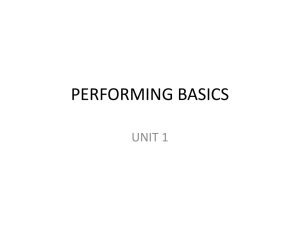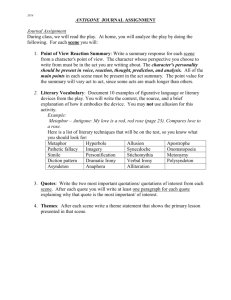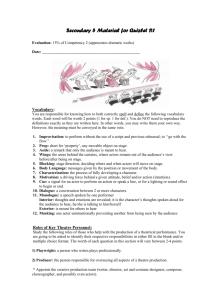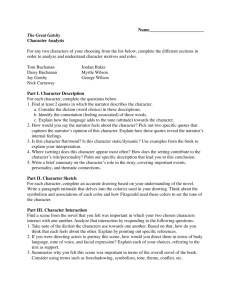Embedded Assessment 4 2 Anitgone Tableau
advertisement
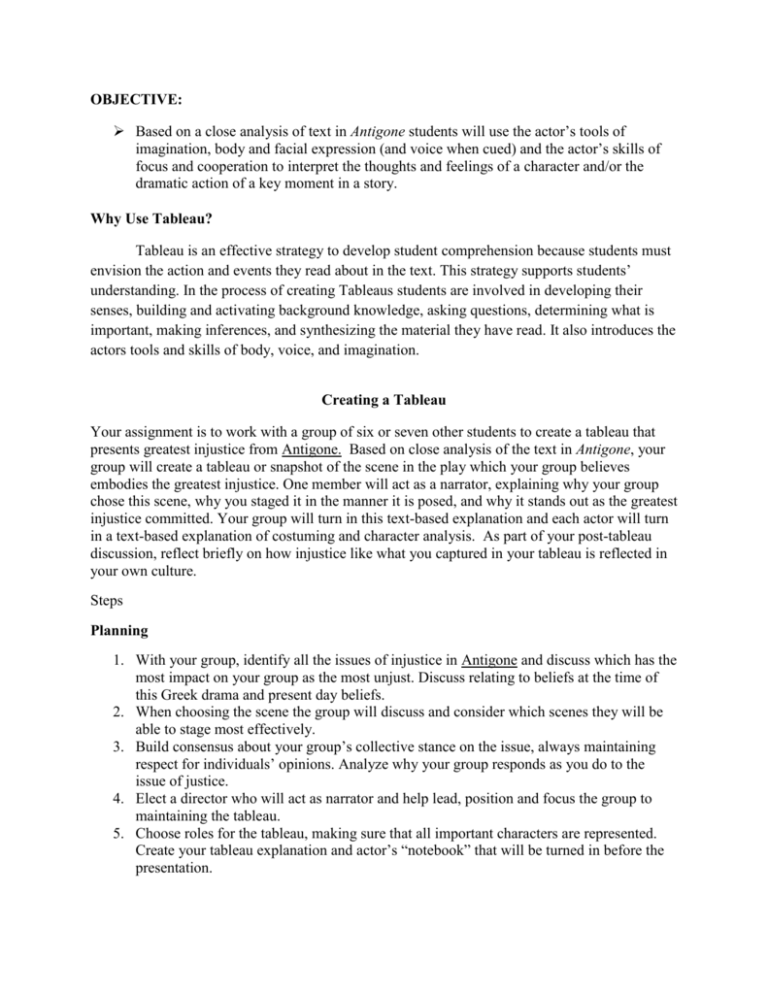
OBJECTIVE: Based on a close analysis of text in Antigone students will use the actor’s tools of imagination, body and facial expression (and voice when cued) and the actor’s skills of focus and cooperation to interpret the thoughts and feelings of a character and/or the dramatic action of a key moment in a story. Why Use Tableau? Tableau is an effective strategy to develop student comprehension because students must envision the action and events they read about in the text. This strategy supports students’ understanding. In the process of creating Tableaus students are involved in developing their senses, building and activating background knowledge, asking questions, determining what is important, making inferences, and synthesizing the material they have read. It also introduces the actors tools and skills of body, voice, and imagination. Creating a Tableau Your assignment is to work with a group of six or seven other students to create a tableau that presents greatest injustice from Antigone. Based on close analysis of the text in Antigone, your group will create a tableau or snapshot of the scene in the play which your group believes embodies the greatest injustice. One member will act as a narrator, explaining why your group chose this scene, why you staged it in the manner it is posed, and why it stands out as the greatest injustice committed. Your group will turn in this text-based explanation and each actor will turn in a text-based explanation of costuming and character analysis. As part of your post-tableau discussion, reflect briefly on how injustice like what you captured in your tableau is reflected in your own culture. Steps Planning 1. With your group, identify all the issues of injustice in Antigone and discuss which has the most impact on your group as the most unjust. Discuss relating to beliefs at the time of this Greek drama and present day beliefs. 2. When choosing the scene the group will discuss and consider which scenes they will be able to stage most effectively. 3. Build consensus about your group’s collective stance on the issue, always maintaining respect for individuals’ opinions. Analyze why your group responds as you do to the issue of justice. 4. Elect a director who will act as narrator and help lead, position and focus the group to maintaining the tableau. 5. Choose roles for the tableau, making sure that all important characters are represented. Create your tableau explanation and actor’s “notebook” that will be turned in before the presentation. Creating What is Tableau? Students make a frozen picture to help break down a story, analyze the sequence of events, identify the important aspects of the story, and bring it to life. The actor’s expressive faces, body poses, and how they pose in relationship to one another creates a living picture or sculpture. In its simplest form students simply freeze to capture a moment in time. Tableaus tell a clear story about events, people or place. Tableaus develop empathy or emotions of characters in the story. Tableaus require students to focus their attention and freeze their bodies and faces to show action. Tableaus require attention to composition: - position of bodies to create interest and understanding - varying of body levels ( high, middle or low positions) Students will form a group and create a tableau that displays a snapshot of the scene in Antigone that your group agrees shows the greatest injustice. Actors should create a picture that shows the action and the emotions of the character. Actors will attempt to put together a costume that is appropriate. They will also keep a log where they describe their real costume and explain why it was chosen based on the text of Antigone, and they will then describe the ideal costume. Actors will also answer questions regarding characterization in the log that they turn in to the teacher. One student will be elected as the narrator. After the actors are frozen in place, that student will explain which scene is portrayed, why this scene was chosen as the greatest injustice, and who each student is portraying. The narrator will also act as the director during rehearsal times and for the final tableau insuring the actors are in the correct place. Director’s Job Students need to elect one person to be the director and the narrator. The entire group should collaborate on how to stage their frozen picture. The director is able to observe and make sure that the spacing and positioning are correct and that the character expressions are evident when actors are frozen in the tableau before the director takes their place as narrator and presents the explanation to the class based on the text of Antigone. When positioning the tableaus, be sure to create an interesting picture. Actors should not be standing in straight line; there should be levels. The scene should have a focal point that draws the audience’s eye. The scene should be staged to reflect where and when the action is happening. The poses should reflect actor’s emotions and also their status in the scene based on the text of Antigone. For example, the king would be placed appropriately as opposed to a slave; they would not be staged equally. Also, main characters would tend to be at the forefront unless there is a purposeful placement in the back that showed characterization and plot. Narrator’s Job The narrator presents which scene is portrayed, why this scene was chosen as the greatest injustice, and who each student is portraying. In the planning stage, the group should have discussed why the scene they chose represents the greatest injustice based on the text of Antigone. The narrator should record that and rewrite so that it is ready to be spoken to the class. Actor’s Job The actors will create and hold the tableau throughout the time the narrator is speaking through the class. The actors should hold position and characterization throughout. Actors should put together an appropriate costume that reflects their character. Actors will turn in an Actor’s log that answers IN Detail the following questions with support from the text of Antigone: 1. 2. 3. 4. 5. 6. Where are you? Are you comfortable in this place? Why/Why not? What has just happened and what are you witnessing? How do you feel about this? Do you side one way or the other? Explain. How do you feel about the other characters in this scene? Explain. How are you standing physically? Does your posture reflect your emotion? How? Does your staging reflect your age? Your social status? Explain why you are staged as you are and what facial expression you are showing. Refining and Presenting 1. The actors portraying characters should practice arranging themselves in a way that reflects the various characters’ perspectives on the issue of justice. Consider overall aesthetic appeal, proximity of characters to each other, height of characters in relation to each other, body language, frozen gestures, and so on. 2. Rehearse freezing at once, holding for awhile, and then unfreezing at same time. The transition between freezing and unfreezing should be silent and simultaneous. 3. The narrator should practice saying his lines clearly, loudly, and at an even pace. The actors should practice holding their position for the entire time the narrator speaks so that they do not break the picture for the final presentation. 4. After the presentation, you will write a reflection on your experience.



